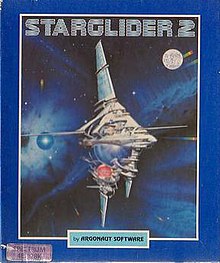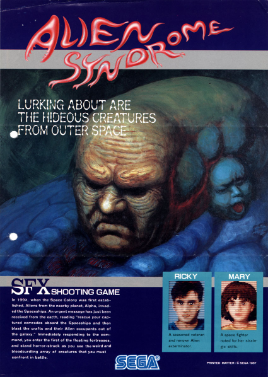
Alien Syndrome is a run and gun video game developed by Sega and released in arcades in 1987, and later ported to the Master System in 1988. The game utilizes a side-scrolling feature that allows the player to take control of either a male (Ricky) or female (Mary) soldier whilst hunting aliens and saving hostages before they run out of time.
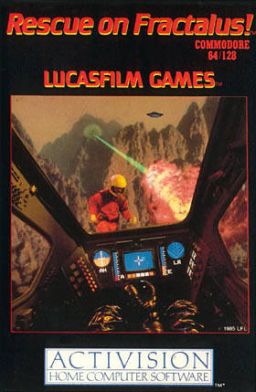
Rescue On Fractalus! is a space combat simulator video game created by Lucasfilm Games. It was originally released in 1985 for the Atari 8-bit computers and Atari 5200 console, then ported to the Apple II, ZX Spectrum, Amstrad CPC, Tandy Color Computer 3, and Commodore 64. The player flies a space fighter near the surface of a planet, with the goal of rescuing downed pilots. The terrain is generated via fractals, from which the eponymous planet and game title are taken.

Mercenary is a 3D action-adventure game written for the Atari 8-bit computers and published by Novagen Software in 1985. It was converted to the Commodore 64, ZX Spectrum, Amstrad CPC, Atari ST, Amiga, and Commodore 16/116/Plus/4. The game uses vector graphics renderings of vast, sparse environments and has open-ended gameplay. It was also released as Mercenary: Escape from Targ and Mercenary: A Flight Simulator Adventure.

Stunt Car Racer is a racing video game developed by Geoff Crammond. It was published in 1989 by MicroProse, under their MicroStyle and MicroPlay labels in the United Kingdom and in the United States, respectively. The game pits two racers on an elevated track on which they race in a head-to-head competition, with ramps they must correctly drive off as the main obstacle.
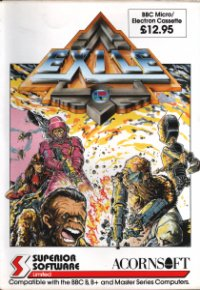
Exile is a single-player action-adventure video game originally published for the BBC Micro and Acorn Electron in 1988 by Superior Software and later ported to the Commodore 64, Amiga, CD32 and Atari ST, all published by Audiogenic. The game was designed and programmed by Peter Irvin and Jeremy Smith. It is often cited as one of the earliest examples of a Metroidvania game and featured "realistic gravity, inertia and object mass years before players understood the concept of a physics engine... an astounding level of AI, stealth-based gameplay, a logical ecosystem governing the world's creatures and a teleportation mechanic that feels startlingly like a predecessor to Portal".
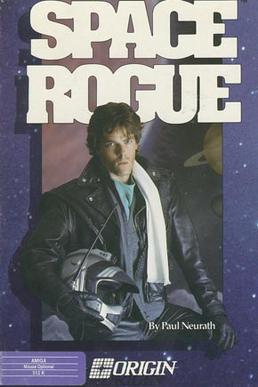
Space Rogue is a space flight simulation video game developed by Origin Systems and published by Origin Systems, Wave Brain, and Night Dive Studios. The game was released in 1989 for Apple II and Commodore 64; the series was later ported to DOS, Macintosh, Amiga, and Atari ST. The game was also released in the Japanese language for PC-9801, X68000, and FM Towns. The FM Towns version had its intro remade with slight animations and new illustrations, along with scrolling Japanese text, and exclusive CD quality background music. Taking place within the Far Arm of the Milky Way galaxy, Space Rogue's main story revolves around the player character's efforts to pursue a career and undertake long-range goals beyond his immediate mission.
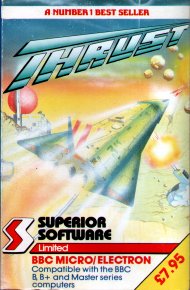
Thrust is a 1986 video game programmed by Jeremy C. Smith for the BBC Micro and published by Superior Software. The player's aim is to manoeuvre a spaceship by rotating and thrusting, as it flies over a two-dimensional landscape and through caverns. The gameplay of Thrust was heavily inspired by Atari's Gravitar.

Star Goose is a vertically scrolling shooter that was published for the Amiga, Atari ST, and MS-DOS by Logotron in 1988. The player controls Scouser-Gitt, who pilots the eponymous Star Goose, a vessel that has been commissioned to scour the planet Nom and collect 48 crystals. Players must collect all six crystals in each of the game's eight levels to advance, while at the same time avoiding or destroying enemies and maintaining their shield, ammunition, and fuel levels. The game's surfaces are contoured, which affects the way that bullets travel, and contain tunnels that switch modes to a three-dimensional perspective where the player can replenish their resources.

Xenon 2: Megablast is a 1989 shoot 'em up video game developed by The Bitmap Brothers and published by Image Works for the Amiga and Atari ST. It was later converted to the Master System, PC-98, X68000, Mega Drive, Commodore CDTV, Game Boy, Acorn Archimedes and Atari Jaguar platforms. The game is a sequel to Xenon and takes place a millennium after the previous title. The goal of the game is to destroy a series of bombs planted throughout history by the Xenites, the vengeful antagonists of the first game.
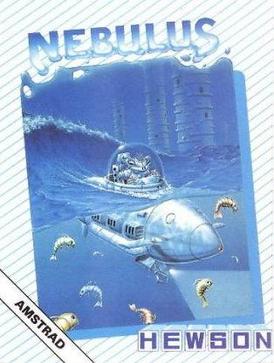
Nebulus is a platform game created by John M. Phillips and published by Hewson Consultants in the late 1980s for home computer systems. International releases and ports were known by various other names: Castelian, Kyorochan Land, Subline, and Tower Toppler.

Carrier Command is a 1988 video game published by Rainbird for the Amiga, Atari ST, IBM PC compatibles, ZX Spectrum, Macintosh, Commodore 64, and Amstrad CPC. Carrier Command is a cross between a vehicle simulation game and a real-time strategy game where players control a robotic aircraft carrier.
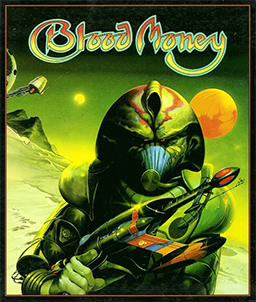
Blood Money is a side-scrolling shooter video game developed by DMA Design and published by Psygnosis in 1989 for the Amiga, Atari ST, and MS-DOS. A Commodore 64 version followed in 1990. The game is set in four different locations on a planet, where the player must fight off enemies and bosses.

Awesome is a science fiction action video game released by Psygnosis for the Amiga in 1990. It features a variety of gameplay styles, from overhead shooting to Asteroids-esque sequences, and a pre-rendered ray-traced intro. The objective is to traverse the galaxy despite not having funds or fuel to do it.
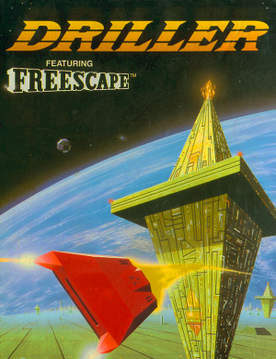
Driller is a 1987 puzzle video game. It was written by British developers Major Developments and published by Incentive Software for the ZX Spectrum, Commodore 64, Amstrad CPC, Amiga, Atari ST, and MS-DOS. It uses the Freescape 3D game engine.

Starglider is a 3D video game published in 1986 by Rainbird. It was developed by Jez San under his company name Argonaut Software. The game is a fast-moving, first-person combat flight simulator, rendered with colourful wireframe vector graphics inspired by San's love of the 1983 Atari coin-op Star Wars.

Arcticfox is a science fiction tank simulation video game developed by Dynamix and published by Electronic Arts in 1986. It was published in Europe by Ariolasoft. A sequel to Dynamix's Stellar 7, Arcticfox was developed for the Amiga as one of the platform's first titles but was quickly ported to other platforms including the Atari ST, Commodore 64, ZX Spectrum, MS-DOS and Apple II. A third game was released in the series in 1991 titled Nova 9: The Return of Gir Draxon.

Hostages is a 1988 tactical shooter video game developed and published by Infogrames for the Acorn Electron, Archimedes, Atari ST, Amiga, Apple IIGS, Amstrad CPC, BBC Micro, Commodore 64, MS-DOS, MSX, Nintendo Entertainment System, and ZX Spectrum. The game depicts a terrorist attack and hostage crisis at an embassy in Paris, with the player controlling a six-man GIGN counterterrorist team as they are deployed to defeat the terrorists and free their hostages.
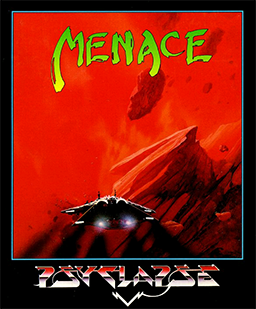
Menace is a horizontally scrolling shooter developed by DMA Design and published by Psygnosis. It was originally released for the Amiga in 1988, and was ported for the Atari ST, Commodore 64, and MS-DOS in 1989. The game is set on the planet of Draconia, where players are tasked with destroying the planet's defence mechanisms in order to kill the harmful creatures.

Superman: The Man of Steel is a 1989 video game featuring the DC Comics character Superman. It was developed and published by UK software company Tynesoft under license from First Star Software.

Ghostbusters II is a 1989 action game based on the film of the same name. It was published by Activision for various computer platforms. British studio Foursfield developed a version for Commodore 64, Amiga, Atari ST, Amstrad CPC and ZX Spectrum, which also got ported to the MSX by New Frontier. It features three levels based on scenes from the film. Dynamix developed a separate version for the DOS, also based on the film. The non-DOS versions were praised for the graphics and audio, but criticized for long loading times, disk swapping, and the final level. The DOS, Commodore 64 and Amiga versions were the only versions released in North America.
